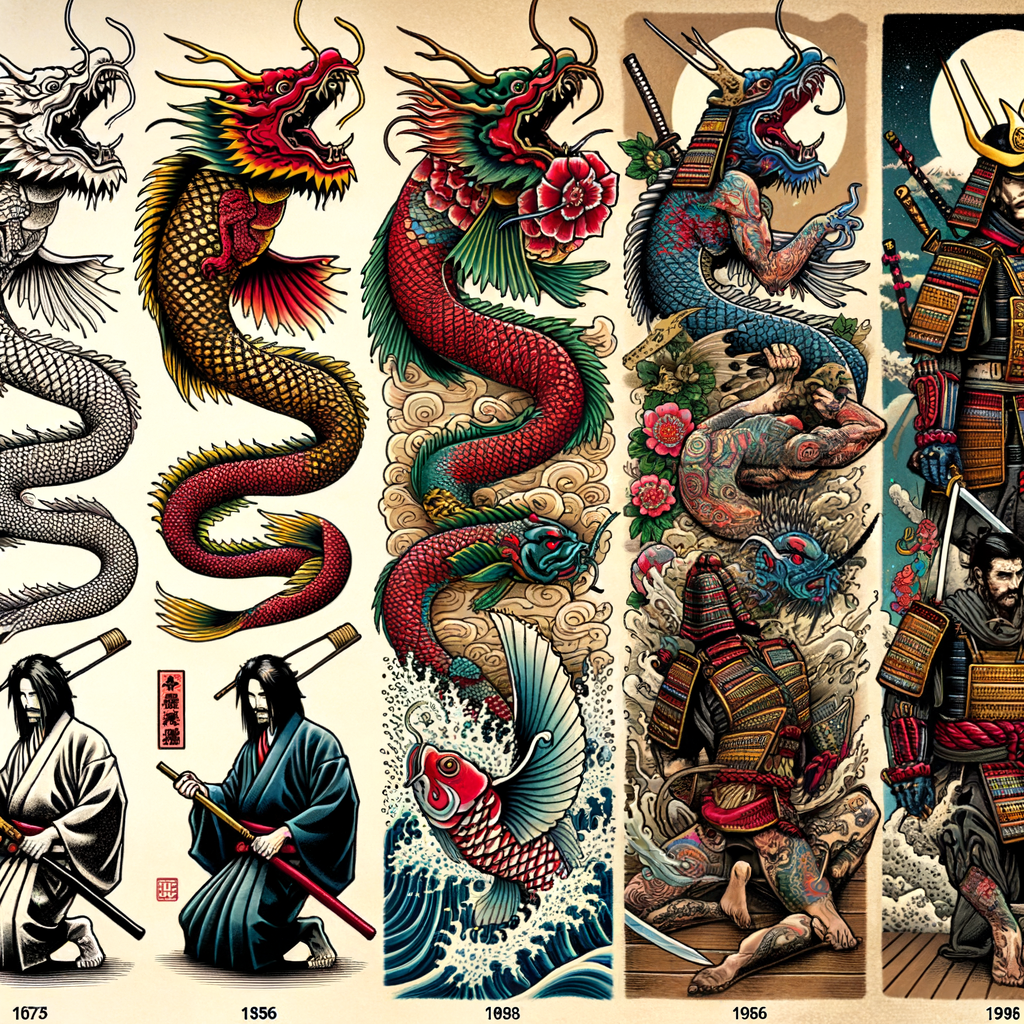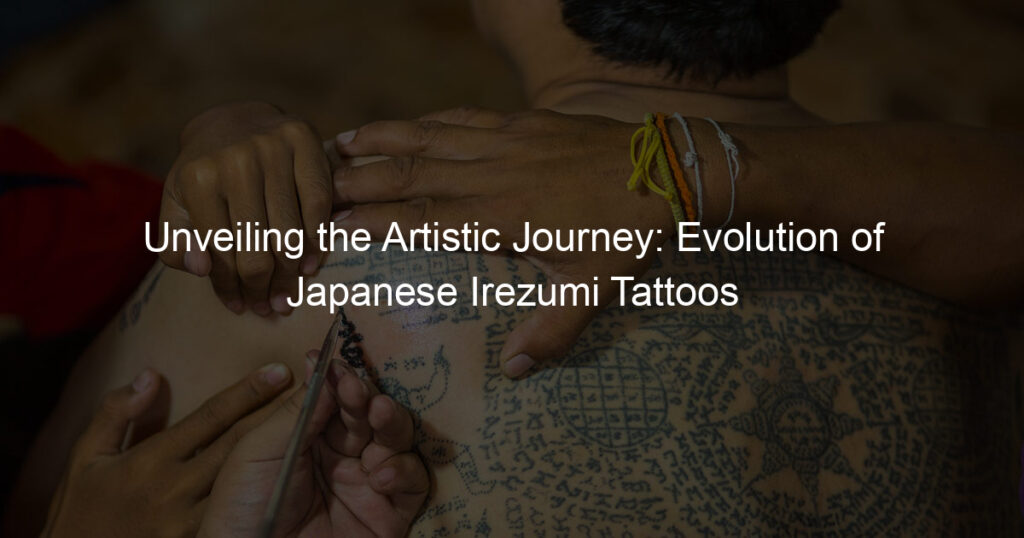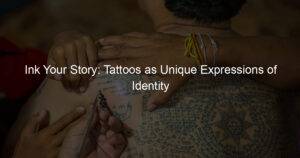
Introduction to Japanese Irezumi Tattoos
Japanese Irezumi tattoos, a form of body art deeply rooted in the country’s history and culture, are a fascinating topic to explore. This article will delve into the definition of Japanese Irezumi tattoos and their significance in Japanese culture.
Irezumi is a Japanese word that translates to ‘insert ink’. This term is used to describe the traditional method of hand-poking tattoos into the skin. The art of Irezumi is intricate and detailed, often featuring motifs from Japanese folklore and history. These tattoos are typically large, covering large portions of the body such as the back, chest, or entire arms, and are known for their bold colors and intricate details.
Japanese Irezumi tattoos hold a significant place in Japanese culture. Historically, they were associated with the Yakuza, Japan’s organized crime syndicates, and were seen as a sign of rebellion or criminality. However, in modern times, the perception of Irezumi has shifted significantly. Today, these tattoos are recognized as a form of art and self-expression, and they are celebrated for their beauty, intricacy, and the skill required to create them.
Despite the historical stigma, Irezumi tattoos have played a crucial role in shaping Japan’s cultural identity. They are a testament to the country’s rich history and tradition, and they continue to influence contemporary art and fashion in Japan and around the world.
In the following sections, we will delve deeper into the history of Japanese Irezumi, explore traditional Japanese tattoo designs, and discuss the current state of the Japanese tattoo culture. Stay tuned to learn more about the fascinating world of Japanese Irezumi tattoos.
History of Japanese Irezumi
The history of Japanese Irezumi tattoos is as rich and intricate as the designs themselves. Let’s delve into the origins of this unique art form.
Origins of Irezumi Tattoo History
The story of Irezumi begins thousands of years ago, with the earliest evidence of tattooing in Japan dating back to the Jomon period (10,000 B.C. to 300 B.C.).
-
- Early Beginnings of Japanese Tattoo Evolution
In the Jomon period, tattoos were often used for spiritual or status purposes. The Ainu people, indigenous to Japan, used tattoos for social and religious rites. Women, in particular, would have intricate designs on their arms and hands. These early tattoos were created by cutting the skin and rubbing soot into the wounds, a far cry from the sophisticated techniques used in Irezumi today.
-
- Influence of Traditional Japanese Tattoos on Irezumi
As time progressed, the art of tattooing in Japan evolved. During the Edo period (1603-1868), tattoos became more elaborate and colourful, influenced by woodblock prints and the culture of the time. The term ‘Irezumi’ was born during this period, meaning ‘inserting ink’. The designs often depicted folklore, religious themes, and nature, elements still prevalent in Irezumi today.
Understanding the history of Irezumi provides a deeper appreciation for this art form. It’s not just about the aesthetic appeal, but also the rich cultural heritage it represents.
| Period | Tattoo Usage | Techniques |
|---|---|---|
| Jomon period | Spiritual and status symbols | Cutting skin and rubbing soot |
| Edo period | Artistic expression, influenced by woodblock prints | Inserting ink, known as Irezumi |
Evolution of Tattoos in Japan
The art of tattooing in Japan has a rich and complex history. It has evolved over centuries, shaped by cultural and social changes. Let’s delve into the fascinating journey of Japanese tattoo art.
-
- Changes in Japanese Tattoo Art Over the Centuries
Japanese tattoos, known as Irezumi, have undergone significant changes over the centuries. In the early days, tattoos were seen as a form of punishment or branding for criminals. However, by the Edo period (1603-1868), tattoos began to be associated with the brave and the heroic, often worn by firefighters and laborers as symbols of strength and courage.
During the Meiji era (1868-1912), tattoos were outlawed in an attempt to modernize Japan and align with Western values. This led to the development of a secretive tattoo culture, with artists working underground. The designs became more intricate and detailed, often telling stories or representing folklore.
In the 20th century, with the influence of pop culture and globalization, Japanese tattoos started to gain international recognition. The traditional style of Irezumi became a source of inspiration for tattoo artists worldwide.
-
- Impact of Social and Cultural Shifts on Japanese Tattoo Evolution
Social and cultural shifts have played a significant role in the evolution of Japanese tattoos. For instance, during the Edo period, the popularity of ukiyo-e, woodblock prints, influenced the designs of tattoos. The vibrant colors and intricate details of ukiyo-e were incorporated into tattoo designs, leading to the birth of the full-body tattoo, known as “horimono”.
Another cultural shift occurred during the Meiji era when tattoos were banned. This led to a shift in perception, with tattoos being associated with the Yakuza, the Japanese mafia. Despite this negative association, the art of tattooing continued to evolve, with artists developing their unique styles and techniques.
Today, the perception of tattoos in Japan is slowly changing. While still not fully accepted in mainstream society, tattoos are becoming more common, especially among the younger generation. This shift in societal attitudes is likely to continue influencing the evolution of Japanese tattoo art.
Traditional Japanese Tattoos
Traditional Japanese tattoos, also known as Irezumi, have a rich history and are deeply rooted in the country’s culture. They are characterized by their unique style, themes, and techniques.
Characteristics of Traditional Irezumi Tattoos
Traditional Irezumi tattoos are known for their distinctive features. Let’s delve into the common themes and symbols, as well as the techniques and tools used in creating these remarkable pieces of art.
-
- Common Themes and Symbols in Traditional Japanese Tattoos
Traditional Japanese tattoos often depict themes from nature, folklore, and mythology. Common symbols include the dragon, symbolizing strength and wisdom, and the koi fish, representing perseverance and determination. Cherry blossoms, which stand for the fleeting nature of life, are also a popular choice.
-
- Techniques and Tools Used in Traditional Irezumi
The process of creating traditional Irezumi tattoos is both intricate and time-consuming. Artists use a set of tools known as Nara ink brushes, made from bamboo and steel. The technique, called “hand poking,” involves inserting the ink into the skin by hand, rather than using a machine. This method allows for greater precision but can be more painful and time-consuming.
Understanding these characteristics not only enhances our appreciation for traditional Japanese tattoos but also provides insight into the cultural significance they hold. From the themes and symbols they depict to the techniques and tools used in their creation, each Irezumi tattoo tells a unique story that is deeply intertwined with Japanese culture and history.
Significance of Traditional Japanese Tattoos
Traditional Japanese tattoos, known as Irezumi, hold a significant place in Japanese culture. They are more than just body art; they are a reflection of the country’s history, beliefs, and societal norms. Let’s delve into the role of these tattoos in Japanese society and the symbolism and meanings behind them.
-
- Role of Tattoos in Japanese Society
In ancient Japan, tattoos were often associated with the working class and were used as a form of identification. Fishermen, for instance, would get tattoos of sea creatures as a form of protection. Over time, tattoos began to be associated with the Yakuza, the Japanese mafia, leading to a negative perception of tattoos in Japanese society. However, in recent years, there has been a resurgence in the popularity of traditional Japanese tattoos, with many young people embracing this ancient art form.
-
- Symbolism and Meanings Behind Traditional Japanese Tattoos
Every traditional Japanese tattoo carries a specific meaning and symbolism. For example, a Koi fish symbolizes luck, prosperity, and good fortune, while a dragon represents strength, wisdom, and protection. Cherry blossoms, another popular tattoo design, symbolize the transient nature of life due to their short blooming times. These symbols are deeply rooted in Japanese folklore and mythology, making each tattoo a unique piece of art with its own story.
In conclusion, traditional Japanese tattoos are a significant part of Japan’s cultural heritage. They provide a fascinating insight into the country’s history, societal norms, and belief systems. Despite the changing perceptions of tattoos in Japanese society, the art of Irezumi continues to thrive, carrying forward the rich traditions and symbolism of ancient Japan.
Irezumi Tattoo Designs
Irezumi tattoos are a significant part of Japanese culture. They are not just body art, but a form of self-expression that carries deep meanings and symbolism. Let’s explore some popular Irezumi designs and their meanings.
Popular Japanese Tattoo Designs
-
Overview of Popular Irezumi Designs
There are numerous Irezumi designs, each with its unique symbolism and aesthetic appeal. Here are a few popular ones:
Design Description Koi Fish Symbolizes determination and courage, often depicted swimming upstream. Cherry Blossoms Represents the fleeting nature of life due to their short blooming times. Dragons Signifies strength, wisdom, and protection. -
Meanings Behind Popular Japanese Tattoo Designs
Each Irezumi tattoo design carries a specific meaning, often rooted in Japanese folklore and tradition. Here’s what some popular designs symbolize:
- Koi Fish: These are symbols of perseverance and strength. The legend of the Koi fish swimming upstream to become a dragon is a popular story in Japanese culture.
- Cherry Blossoms: These beautiful flowers are a reminder of the transient nature of life, symbolizing the beauty and brevity of our existence.
- Dragons: Dragons are revered creatures in Japanese mythology. They symbolize wisdom, strength, and protection.
Choosing an Irezumi design is a personal journey. It’s essential to understand the symbolism behind each design to ensure it aligns with your personal beliefs and values.
Creating a Japanese Tattoo Design
Designing a Japanese tattoo, also known as an Irezumi, is a process that requires careful thought and consideration. It’s not just about picking a design that looks cool. It’s about choosing a design that has meaning and significance to you. Let’s explore the process of designing an Irezumi tattoo and how to choose the right design for your Japanese tattoo.
- Process of Designing an Irezumi TattooDesigning an Irezumi tattoo is a journey that begins with understanding the rich history and symbolism behind Japanese tattoos. The first step is to research and learn about the different types of Irezumi designs and their meanings. For example, a Koi fish represents strength and perseverance, while a cherry blossom symbolizes the fleeting nature of life.
Once you have an understanding of the different designs, the next step is to work with a tattoo artist who specializes in Japanese tattoos. They can help you create a design that not only looks beautiful but also tells a story that is meaningful to you. This process can take time, but it’s worth it to ensure that your tattoo is a true reflection of your personal journey.
- Choosing the Right Design for Your Japanese TattooChoosing the right design for your Japanese tattoo is a personal decision. It’s important to choose a design that resonates with you and reflects your personality, values, or experiences. Here are a few tips to help you choose the right design:
- Reflect on what you want your tattoo to represent: Do you want it to symbolize a personal achievement, a life-changing experience, or a value that you hold dear? Reflecting on this can help you choose a design that has deep personal significance.
- Consider the symbolism of different designs: Japanese tattoos are rich in symbolism. Understanding the meanings behind different designs can help you choose a design that aligns with what you want your tattoo to represent.
- Work with a skilled tattoo artist: A skilled tattoo artist can help you refine your ideas and create a design that is unique and meaningful to you.
Remember, a tattoo is a lifelong commitment. So, take your time, do your research, and choose a design that you’ll be proud to wear for the rest of your life.
Japanese Tattoo Culture Today
Japanese tattoo culture is a vibrant and ever-evolving art form. Today, it continues to captivate audiences worldwide with its rich symbolism, intricate designs, and deep cultural roots. Let’s delve into the modern interpretations of this traditional art form.
Modern Interpretations of Japanese Tattoo Art
Modern Japanese tattoo art is a fascinating blend of traditional motifs and contemporary aesthetics. Artists today are pushing boundaries, experimenting with styles, and creating unique designs that still respect and reflect the age-old traditions of Japanese tattooing.
-
- How Modern Artists are Evolving Japanese Tattoo Art
Modern artists are revolutionizing Japanese tattoo art by incorporating new techniques and styles into their work. They are using digital tools for design precision, experimenting with color palettes, and even blending Western styles with traditional Japanese motifs. This fusion of old and new is creating a fresh wave of Japanese tattoo art that is both innovative and respectful of its roots.
-
- Contemporary Trends in Japanese Tattoo Designs
Contemporary Japanese tattoo designs are seeing a resurgence of traditional motifs like koi fish, dragons, and cherry blossoms, but with a modern twist. These designs often feature bold lines, vibrant colors, and a more abstract approach. Minimalistic designs are also gaining popularity, offering a more subtle and understated take on the traditional art form.
In conclusion, the Japanese tattoo culture today is a dynamic and evolving landscape. It is a testament to the enduring appeal of this traditional art form and its ability to adapt and thrive in the modern world. Whether through the innovative techniques of modern artists or the contemporary trends in design, Japanese tattoo art continues to captivate and inspire.
Japanese Tattoos in Popular Culture
Japanese tattoos, also known as Irezumi, have made a significant impact on popular culture around the world. This influence is particularly evident in Western tattoo culture, as well as in film, music, and fashion. Let’s explore these influences in more detail.
-
- Influence of Japanese Tattoos on Western Tattoo Culture
Japanese tattoos have greatly influenced Western tattoo culture. The intricate designs, rich symbolism, and deep cultural roots of Irezumi have inspired many Western tattoo artists. For example, the Koi fish, a popular Japanese tattoo symbol, represents strength and perseverance. It’s now common to see this symbol in Western tattoo designs. Similarly, the Japanese cherry blossom, symbolizing the fleeting nature of life, has also found its way into Western tattoo art.
-
- Japanese Tattoos in Film, Music, and Fashion
Japanese tattoos have also made a significant impact on film, music, and fashion. In many movies, characters with Japanese tattoos are often portrayed as strong, resilient, or mysterious. For example, in the film “The Wolverine”, the character Logan sports a full back Irezumi, highlighting his warrior spirit.
In the music industry, artists like Lady Gaga and Post Malone have embraced Japanese tattoo designs, influencing their fans and further popularizing Irezumi. In fashion, Japanese tattoos have inspired clothing designs, accessories, and even entire fashion lines. For instance, fashion brands like Ed Hardy have incorporated Japanese tattoo designs into their clothing, making them popular worldwide.
In conclusion, the influence of Japanese tattoos on popular culture is undeniable. They have not only shaped the Western tattoo culture but also left a significant mark on film, music, and fashion. As we continue to appreciate and understand the depth of Japanese tattoo art, its influence will undoubtedly continue to grow.
Conclusion: The Continuing Evolution of Japanese Irezumi Tattoos
As we’ve journeyed through the rich history and vibrant culture of Japanese Irezumi tattoos, it’s clear that this art form is much more than just skin deep. It’s a tradition steeped in symbolism, storytelling, and personal expression. But what does the future hold for this ancient art form? Let’s explore.
-
- Future of Japanese Tattoo Art
Japanese Irezumi tattoos continue to evolve, blending traditional techniques with modern styles. Today, more and more artists are incorporating digital technology into their work, creating intricate designs with a level of detail that was once unimaginable. However, despite these advancements, the core principles of Irezumi remain the same: respect for tradition, mastery of craft, and a deep understanding of symbolism.
-
- Preserving the Tradition of Japanese Irezumi
While the future of Japanese Irezumi tattoos is exciting, it’s equally important to preserve the tradition that has shaped this art form for centuries. Many tattoo artists in Japan are committed to keeping the ancient techniques alive, passing them down to the next generation. They understand that the true value of Irezumi lies in its history and cultural significance, not just its aesthetic appeal.
In conclusion, the world of Japanese Irezumi tattoos is a fascinating blend of old and new, tradition and innovation. As we look to the future, we can expect this art form to continue evolving, while always staying true to its roots. Whether you’re a tattoo enthusiast or simply a lover of art and culture, there’s no denying the power and beauty of Japanese Irezumi.














